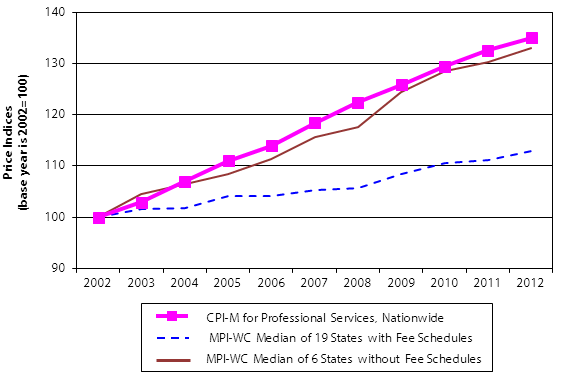The national medical price index is a poor measure of workers’ comp price inflation in most states, says a new 25-state study from the Workers Compensation Research Institute (WCRI).
Unlike the consumer price index for medical care (CPI-M), which measures general prices paid for medical services, WCRI’s Medical Price Index for Workers’ Compensation, Fifth Edition (MPI-WC), focuses only on the prices paid for the medical care that injured workers receive under their state’s workers’ compensation system.
The CPI-M for professional services poorly tracked the workers’ compensation price trends for states with fee schedules. For states with no fee schedules, growth in CPI-M was fairly similar to workers’ compensation price trends.
“This study is designed to help public policymakers and system stakeholders understand how prices paid for medical professional services for injured workers in their states compare with other states and know if prices in their state are rising rapidly or relatively slowly,” said Dr. Richard Victor, executive director of WCRI. “They can also learn if the reason for price growth in their state is part of a national phenomenon or whether the causes are unique to their state and hence, subject to local management or reform.”

The study findings indicate that:
- Prices paid were higher in states with no fee schedule regulations for professional services as compared with fee schedule states.
- There were more variations in prices paid across states for major surgeries than for primary care services.
- Prices grew more rapidly over the study period in states with no fee schedules compared with states with fee schedules.
- In states with fee schedules, changes in actual prices paid followed changes in fee schedules.
- Prices paid for services not covered by fee schedules grew more rapidly compared with services covered by fee schedules.
The report includes 25 states that represent nearly 80 percent of the workers’ compensation benefits paid in the U.S. and covers 11 years from 2002 to 2012 for nonhospital, nonfacility services billed by physicians, physical therapists and chiropractors. The medical services fall into eight major groups: evaluation and management, physical medicine, surgery, major radiology, minor radiology, neurological and neuromuscular testing, pain management injections and emergency care.
Click on the following link to download a free copy of this report: http://www.wcrinet.org/studies/public/books/wcri_mpi_5_final.pdf.
Source: WCRI
Was this article valuable?
Here are more articles you may enjoy.

 Truckers Who Fail English Tests Get Pulled Off Roads in Trump Crackdown
Truckers Who Fail English Tests Get Pulled Off Roads in Trump Crackdown  Toyota Unveils Concept LFA Supercar, and It’s Fully Electric
Toyota Unveils Concept LFA Supercar, and It’s Fully Electric  Florida And East Coast Will See Big Losses From More Cat 5 Storms, Researchers Say
Florida And East Coast Will See Big Losses From More Cat 5 Storms, Researchers Say  Tricolor Trustee Plans to Sue Founder for Auto Dealer’s Collapse
Tricolor Trustee Plans to Sue Founder for Auto Dealer’s Collapse 